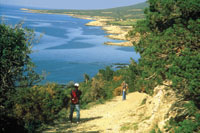Cyprus expands tourism formula

The Mediterranean island of Cyprus offers travellers a range of ‘off the beaten track’ options, and shouldn’t just be seen as a sun, sea and sand destination according to the Cyprus Tourism Organisation, CTO.
Seeking to encourage sustainable tourism development, the CTO initially promoted Agro Tourism as well as working to develop its MICE market, sports tourism and all-year-round visits.
Now, it has launched a major EU-supported Rural Tourism initiative to promote the island's authentic culture and countryside, securing 28 million euros of EU structural funds to invest in the infrastructure and projects to support the sustainable development of rural areas.
The multi-faceted programme include plans for advertising campaigns in specialist consumer titles, exhibiting at agricultural consumer shows, travel trade educational trips, and the production of a dedicated rural tourism guide.
A new logo together with the strap line ‘Rural Cyprus – feeling the experience’ has been created to support the campaign. The logo incorporates a jug, and a sheaf of wheat, symbolising the hospitality and fertility of Cyprus.
Many businessmen, well established in the hospitality and tourism sector, have pointed to the fact that the island needs to diversify its products and also cater to those who want to combine their hobbies with their holidays.
Cyprus gained prominence as a sporting destination – and particularly a venue for sports camps – in the run-up to the Athens Olympics and its mild winter climate makes it an ideal destination for winter training camps for teams from northern Europe. The CTO has, for a number of years, produced maps and guides for cycling trails, nature walks and other special interests as well as encouraging the development of new golf courses and marinas. Diversified programmes will also help raise the economic potential of communities outside the main towns and established tourist destinations. Religious and cultural tourism, adventure and discovery are all being promoted.
However, the island’s appeal as a health tourism centre should not be overlooked according to the CTO. Commerce, Industry and Tourism Minister Antonis Michaelides, speaking at the second international conference on medical tourism in March, said: “Our island, located at the crossroads of the three continents, offers the ideal climate both for treatment and recuperation and a high standard of services for wellness tourists at cost-effective rates.”
Health Tourism, he said, is just one of the many avenues being explored, promoted and supported by the CTO. The government has also recently established a ‘Cyprus Investment Promotion Agency’ to assist potential investors.
The Dubai Financial Group has been among those expressing interest in investment in the island’s health tourism sector.
Recognising the need to update its strategic tourism development plan, Cyprus last year sought the help of Ireland’s Tourism and Transport Consultants (TTC) in researching the field and offering a range of proposals.
The Republic of Cyprus has seen a small decline in the number of visitors to the island – or at best a static market – while facing higher costs and increasing competition from other Mediterranean destinations. The Republic is also losing revenue through movement of visitors across the UN Green Line into north of the island, otherwise accessible only from mainland Turkey. However, despite lower visitor figures, the revenue from tourism actually increased by 2.3 per cent to CYP1.037 billion ($2.44 billion) in 2006 with expenditure per head increasing by 5.2 per cent. In 2005, an average of CYP407 per person was spent on holiday in Cyprus. In 2006, the figure rose to CYP428.
Cyprus meanwhile aims to triple conference tourism by 2010. According to CTO director general, Phoebe Katsouri, over 500 conferences were held in the country last year, attracting some 37,000 participants and bringing in revenue of Cyprus Pounds 200 million. Average attendance, she told a meeting on incentives at the beginning of March, is 84 delegates, who each stay an average of just over five days. CTOP plans to open a Convention Bureau and set up a specialized website to promote conferences, in addition to offering financial incentives.
Katsouri has meanwhile stressed the need for the island to create its own clear and distinct image, focusing on Cyprus’s uniqueness and great diversity in a small geographical space. It is, she said, “A mosaic of nature and culture, a whole magical world concentrated in a small, warm and hospitable Mediterranean island at the crossroads of three continents, between east and west, and offering a multidimensional qualitative tourist experience.”
The CTO’s strategic approach to change in developing the tourism sector, she added, must involve the CTO, the public sector, local authorities and the private sector if it is to be successful. And there must also be mechanisms ‘for systematic monitoring of implementation’. Regional tourism strategies will include: local co-ordinating councils; strategic studies supported by the CTO; agreed regional marketing plans; and co-finance for marketing efforts from the CTO.
A sports tourism action plan set out some three years ago includes provision of infrastructure for 21 sports in all regions; a programme of international sporting events and support for winter training of foreign teams. Many international road racing teams already train on the island while leisure cyclists explore a variety of flat and hilly routes; golf tourism will benefit from plans for between seven and ten new golf courses; and additional planned marinas will increase nautical tourism.
Cyprus faces a number of challenges in its bid to attract more tourists and refine its product but the indications are that all sectors have decided to work together on the issue.
